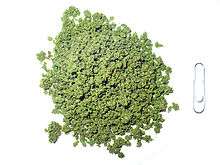
Naswar
Naswār (Pashto: نسوار; Cyrillic script: насва́р), also called nās (ناس; на́с), nāts (ناڅ; на́ц), or nasvay (نسوای; насвай), is a moist, powdered tobacco snuff consumed mostly in Afghanistan, Pakistan, India, Iran, Kazakhstan, Kyrgyzstan, Russia, Tajikistan, Turkmenistan, and Uzbekistan and Ireland. Naswar is stuffed in the floor of the mouth under the lower lip, or inside the cheek, for extended periods of time. It is similar to dipping tobacco and snus.
History
Naswar was introduced into Western Europe by a Spanish monk named Ramon Pane after Columbus' second voyage to the Americas during 1493-1496. In 1561, Jean Nicot, the French ambassador in Lisbon, Portugal, sent naswar to Catherine de' Medici to treat her son's persistent migraines.
Use in Afghanistan, Pakistan, and Central Asia
The green powder form is used most frequently. It is made by pouring water into a cement-line cavity, to which lime or juniper is added as flavorings, and then air-cured, sun-dried, powdered tobacco is added. Indigo is added to the mixture to impart color.
Podcasts:

